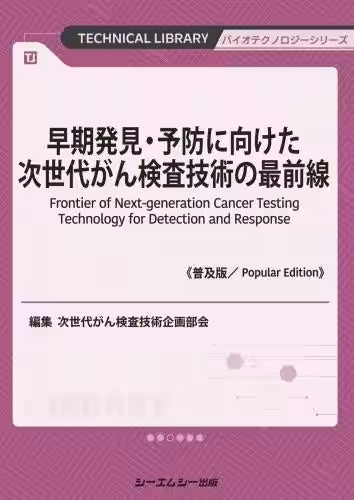

A New Era in Cancer Detection: Non-Invasive Testing Technologies Launching Tomorrow
Non-Invasive Cancer Detection: A Paradigm Shift
Tomorrow marks a significant advancement in the realm of cancer detection with the release of a comprehensive book centered on non-invasive testing techniques. This publication is a must-read for medical professionals, researchers, and anyone interested in understanding the cutting-edge methods of early cancer detection, specifically through biomarker analysis.
About the Book
Published by the Next Generation Cancer Testing Planning Committee, this accessible edition is set to make the sophisticated science behind cancer screening more approachable. The official release date is June 5, 2025, and the book is available in B5 format, spanning 216 pages. The ISBN for the publication is 978-4-7813-1831-8, and it is priced at 4,400 yen (inclusive of tax).
The book offers readers an extensive overview of various aspects of cancer detection, particularly emphasizing on the latest non-invasive methodologies that can drastically improve early diagnosis rates. This edition is particularly pertinent as it serves as a more affordable version for readers, ensuring that critical information is widely disseminated.
Contents Overview
The book meticulously details the latest innovations in cancer screening across several types and advancements in diagnostic technology, divided into five main sections:
Part 1: Lung Cancer Detection
In the first section, readers will find discussions on the potential of saliva cytokine profiling for lung cancer screening, current perspectives on high-sensitivity serum biomarkers for lung cancer, and innovations in lung cancer diagnostic tools using microbead technology. Additionally, the clinical implications of circulating tumor cells (CTCs) in thoracic malignancies are elaborated.
Part 2: Pancreatic Cancer Screening
The second part delves into the promising avenues of saliva metabolomics for pancreatic cancer testing and novel approaches to blood-based biomarkers for early pancreatic cancer diagnostics. The section further explores clinical sequencing using cancer gene panels and prospects of blood-based microRNA diagnostics tailored for pancreatic cancer.
Part 3: Gastrointestinal and Urological Cancer Detection
Covering the third category, readers will be introduced to a pioneered early screening system for colorectal cancer through metabolomics, the identification of CTCs in head and neck cancers, and diagnostic methodologies for urological cancers via exosomes. Also included are innovative attempts at early detection of oral cancers through DNA methylation anomaly identification in gargle samples.
Part 4: Technology Development and Clinical Research
Part four showcases advancements in genomic medicine targeting rare and refractory cancers, alongside the analysis of neoantigens through next-generation sequencing. This section emphasizes the development of micro-biosensors for the electrochemical detection of disease-specific nucleic acids and the emerging technologies of cancer diagnostics, highlighting the future potential of extracellular vesicle capture microchips and smell-based early cancer diagnosis leveraging nematodes.
Part 5: Cancer Screening Businesses and IoT
Finally, the last section presents trends in Japan’s cancer screening practices, clinical applications for circulating tumor DNA, and real-world surveys regarding genetic testing businesses.
Conclusion
The launch of this book represents more than just the publication of new research; it is a reflection of the ongoing efforts to enhance cancer detection methods through innovative and less invasive technologies. Available through major bookstores and the company’s online store, this book is an essential resource for anyone invested in the fight against cancer.
Through the collaboration of an impressive roster of authors from renowned institutions—including Shinshu University, Tokyo University, and various medical centers—the content is crafted to shed light on the future landscape of cancer detection.
Don’t miss out on obtaining this pivotal resource that paves the way for innovative cancer diagnostic methods while also setting a benchmark for future research in the field.
Stay informed, educated, and ready to engage with the latest in cancer screening technology with this enlightening publication.


Topics Health)










【About Using Articles】
You can freely use the title and article content by linking to the page where the article is posted.
※ Images cannot be used.
【About Links】
Links are free to use.